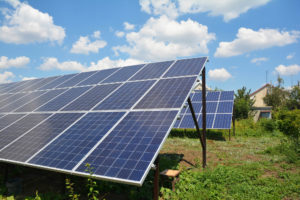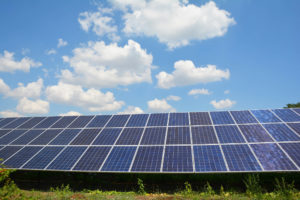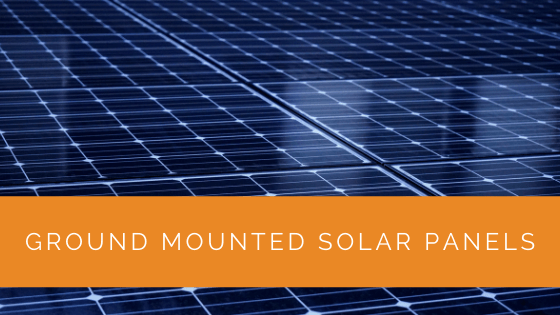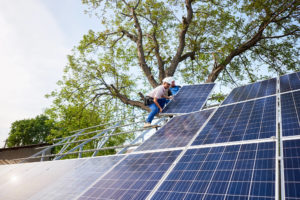A solar panel system is a long-term investment that needs important calculations like the costs you will incur in installation and the return you will receive. The decision on installing solar panels on the ground or on the rooftop is completely dependent on the suitability of the area.
Ground-mounted solar panels are one way of installing solar energy for your property. There are several factors that decide if the project is right for you or not.
Contents
- 1 Key Takeaways
- 2 What Are Ground-Mounted Solar Panels?
- 3 How Do Ground-Mounted Solar Panels Work?
- 4 Why Installing a Ground Mount Solar System a Good Idea?
- 5 Types of Ground-Mounted Solar Systems
- 6 Benefits of Ground-Mounted Solar System
- 7 Is Ground-Mounted Solar Cheaper to Install?
- 8 Frequently Asked Questions About Ground-Mounted Solar Panels
- 9 Case Study: Ground-Mounted Solar Panel System Installation
- 10 Expert Insights From Our Solar Panel Installers About Ground-Mounted Solar Panels
- 11 Discover the Power of Solar with Solar Panels Network
- 12 Final Word
Key Takeaways
- Ground-mounted solar panels are installed at ground level and require sufficient open space with good sunlight for efficient energy production.
- Ground-mounted panels offer more efficiency and safety due to isolation from the house, expandability, and the ability to use dual-axis tracking systems for maximum energy capture.
- While they can be more costly to install than rooftop panels, ground-mounted systems often provide higher energy output due to solar tracking systems. They can be suitable for properties with limited rooftop space or unsupportive rooftops.
What Are Ground-Mounted Solar Panels?
Ground-mounted solar panels are one way of energy production that are installed at the ground level. These are easy to install, cost-effective, and efficient. You need sufficient open space with good sunlight to harness more energy production.
These solar panels can be ground-mounted anywhere from a few inches or feet from the ground. It depends on how the tracking system is set up for the panels to get sunlight and power the inverter. These panels are also called backyard solar panels or free-standing solar panels.
How Do Ground-Mounted Solar Panels Work?
A ground-mounted solar panel uses the same kind of solar panels as the rooftop systems. The difference can be seen in the way it is installed. While installing rooftop solar panels, the racking system is created for an existing structure. For a ground-mounted solar panel system, the support mount needs to be construed as well.
Ground-mounted solar panels need more wiring and electrical connection to avoid any kind of shadow falling on it. 60-cell solar panels are used for homes, and using 72-cell panels is selected for solar farms.
By adjusting the tilt and angle of the ground-mount solar panels capturing sunlight is maximised.
You can increase energy production through tracking systems that allow the panel to face the sun throughout the day. These features are not available for rooftop solar panels as the tilt is limited with the roof’s fixed angle.

Why Installing a Ground Mount Solar System a Good Idea?
Rooftop panels are the most commonly installed solar systems, but there are multiple reasons why a ground-mounted solar array can be the best option for your home. The cost of solar panels for both kinds is the same when it comes to the price per watt.
Installing a ground-mounted system is best when you have a property that isn’t suitable for installing a rooftop solar array due to less space or non-supportive rooftops. It is the most cost-effective to install solar panels in situations when you need more electricity.
Types of Ground-Mounted Solar Systems
There are two kinds of ground-mounted systems that can be used if you are in need of using more electricity.
Standard Ground Mount Systems
Traditional or standard ground mounts make use of ground anchors which hold the racking table that give support to the solar panels on the rails. The placement of the anchor depends on the ground condition. Usually, concrete piers are chosen, but helical piles, driven piers, and concrete ballasts make good alternatives too.
The standard ground mount system holds the solar array in a fixed place with minimal manual adjustments. It is gaining popularity for being the most cost-efficient solution for using renewable energy.
Pole Mounts
For installing a pole mount solar system, one big hole is dug into the ground instead of digging several small holes as with the standard ground mount. After digging the hole, a large pole is placed on the ground, which you can connect with rails and mount solar panels.
The pole mount system offers you great clearance from the ground. It is useful for avoiding foliage or other ground obstacles. Another benefit of pole mounts is that they can easily accommodate single-axis or dual-axis tracking systems, which enables the panels to follow the sun through the day and produce more energy.
Benefits of Ground-Mounted Solar System
After your space requirement is determined, you can start your process of installing the type of solar system suitable for you. Here are a few benefits of ground-mounted solar panels if you decide to install them.
Spacious Rooftop
If your roof is not having enough structural capability to support solar panels, ground-mounted panels are the best option. You need to contact a professional inspector who can decide the suitability.
Rooftop solar panels need replacement after every 10 to 15 years of use. If you need to let your roof have free space without having any system put, then it is better to go for ground-mounted solar panels. Your rooftop system would be more complicated if you had a small space.

More Efficiency
Roof-mounted panels can generate electricity but can have obstacles like trees, chimneys, or other structures that can restrict direct sunlight. Ground-mounted solar panels are easier than rooftop installations and come with a solar tracking system for more potential efficiency. It can have around 10 % to 45 % more efficiency than the rooftop solar system.
The taller poles of ground-mounted panels are suited for bifacial panels that have solar cells on their back to capture the light which is reflected off the ground or hard surface.
Safe
Faulty wiring can result in the risk of fire. By using solar power from a ground-mounted system, the risk is reduced as it’s isolated from your house instead of the rooftop. Instead of being bonded to your home, these panels have independent electrical holds for safe use.
Easily Expandable
You can be in need of extra energy for which expansion of the solar system is needed. This expansion could be for the use of a heat pump or electric vehicle. For such needs, a system of a ground-mounted array of great help. It’s easier to expand, unlike rooftop panels which don’t necessarily have extra space.
Dual-axis system
The pole-mounted systems come with panels that can extract sunlight from both sides and can be tracked through dual-axis systems. This way, you can store the maximum of solar energy. The sun’s position doesn’t have to be always taken into consideration with a dual-sided panel in-ground mounting.
DIY Installation
Certain DIY installation kits are available in the market that is easy and safe for use. You can install it on a single pole for basic energy use. You should remember to obtain requirement permits, follow the local rules and take help from a professional electrician in case you are new or unaware of the ways to install solar panels.
Is Ground-Mounted Solar Cheaper to Install?
Even though ground-mounted solar panels are safer to install due to no work on the roof, the cost of the project can be higher. A few of the reasons are:
- A structure has to build to support the PV panels in a ground-mounted solar panel. A rooftop solar system already is supported by the roof itself.
- Constructing this support structure requires some labour for its instalments.
- The permitting process is complex for the pole-mounted systems as it involves a structural and foundation design which is treated as independent construction
- Even though installing these ground-mounted systems seem costlier, they are more productive as they come with solar tracking systems, which can help in achieving a higher energy output

Frequently Asked Questions About Ground-Mounted Solar Panels
You must have a lot of questions before installing a ground or pole-mounted system. Some of the most frequently asked questions are answered below to help you understand your choice better.
Is It Safe to Install Solar Panels on The Ground?
Installing solar panels on the ground depends on the open land and space, which has proper conditions. It includes having enough ground space and approval from neighbours. It’s a safe way to use solar energy as the connection is far from home.
Are There Single-Axis Systems for Tracking Solar Panels?
There are two kinds of tracking systems available, and you can choose either of them for your solar panels. The choice depends on the use, energy requirement, and tracking needs. A tilted PV panel mount is used in a single-axis tracking system to get the appropriate trajectory for sunlight.
Are There Financing Options for Installing Ground-Mounted Solar Panels?
As the cost of installing such panels is higher, you should consider financing options with a company that helps you. You will find financing options where you can take a loan with different instalment options. There are certain installations that have rebates and incentives, so check the instructions carefully before investing.
Case Study: Ground-Mounted Solar Panel System Installation
Background
A rural property owner in the UK sought a sustainable and cost-effective energy solution to power their household and outbuildings. The property’s vast open land made it an ideal candidate for a ground-mounted solar panel system, as rooftop installation was not feasible due to shading and structural concerns.
Project Overview
The primary objective was to install a ground-mounted solar system that could meet the household’s electricity needs and contribute excess energy to the grid, thereby taking advantage of the Smart Export Guarantee (SEG). The owner also aimed to enhance the property’s environmental footprint by reducing reliance on fossil fuels.
Implementation
- Site Assessment and Planning: The site assessment identified a south-facing area with minimal shading, ideal for solar panel installation. The ground conditions were evaluated for suitability, leading to the decision to use a standard ground-mount system with concrete piers for stability.
- System Selection and Installation: A 10kW system consisting of 40 high-efficiency polycrystalline panels was selected. The panels were arranged in rows with sufficient spacing to avoid shadowing and maximize sunlight capture. The system included a single-axis tracking system to enhance energy production by adjusting the panel orientation throughout the day.
- Grid Connection and Financial Setup: The installation was completed by an MCS-certified installer, ensuring eligibility for the SEG. The owner arranged for the necessary grid connection, allowing the sale of surplus electricity back to the national grid.
Results
- Energy Production: The ground-mounted system produced approximately 12,000 kWh annually, exceeding the household’s energy needs and generating surplus electricity.
- Financial Benefits: The SEG payments provided a steady income stream, estimated at around £600 annually, alongside significant savings on electricity bills. The expected payback period for the system was around 7 years, with ongoing savings thereafter.
- Environmental Impact: The project reduced the property’s carbon footprint by approximately 5,500 kg of CO2 annually, equivalent to planting over 200 trees each year.
Summary
The installation of a ground-mounted solar panel system provided the property owner with a reliable and efficient source of renewable energy, significantly reducing energy costs and contributing positively to the environment. The inclusion of a tracking system further optimized energy production, demonstrating the benefits of ground-mounted solar solutions for properties with ample space.
Expert Insights From Our Solar Panel Installers About Ground-Mounted Solar Panels
Ground-mounted solar panels are an excellent option for properties with ample space. They offer flexibility in positioning and can be set at the optimal angle for maximum sunlight exposure, unlike rooftop systems which are limited by the roof’s angle.
Senior Solar Installation Specialist
One of the key advantages of ground-mounted systems is the ability to use tracking systems. This technology allows the panels to follow the sun throughout the day, significantly increasing energy production compared to fixed rooftop systems.
Renewable Energy Consultant
While the initial cost may be higher due to the need for a support structure and potentially more extensive wiring, the long-term benefits and efficiency gains of ground-mounted solar panels can outweigh these initial expenses.
Solar Energy Advisor
Discover the Power of Solar with Solar Panels Network
Are you navigating the world of solar installations? Look no further than Solar Panels Network, the UK’s trusted partner in harnessing the sun’s potential. Our dedication goes beyond just installations; we’re on a mission to transform how homeowners and businesses across the UK perceive and utilise energy. By choosing us, you’re not only reducing your carbon footprint but also making a smart financial move that promises savings for years ahead. Contact us today and embark on your solar journey.
Final Word
There are different ways to install multiple solar panels, and it all depends on how much space they will need. You might get good deals with ground-mounted solar panels as they are the best way to get solar energy for homeowners. The maintenance costs are lower, and you won’t need to be worried about the safety and position of the sun as there is a tracking system installed.
The solar system is the best renewable energy resource which has immense potential of generating power. It’s a greenway to fulfil your power supply needs. A ground-mounted system can be installed on open land and saves you through rooftop installations.
About the Author
Solar Panels Network stands at the forefront of solar energy solutions, driven by a team of seasoned solar engineers and energy consultants. With over decades of experience in delivering high-quality solar installations and maintenance, we are committed to promoting sustainable energy through customer-centric, tailored solutions. Our articles reflect this commitment, crafted collaboratively by experts to provide accurate, up-to-date insights into solar technology, ensuring our readers are well-informed and empowered in their solar energy decisions.


